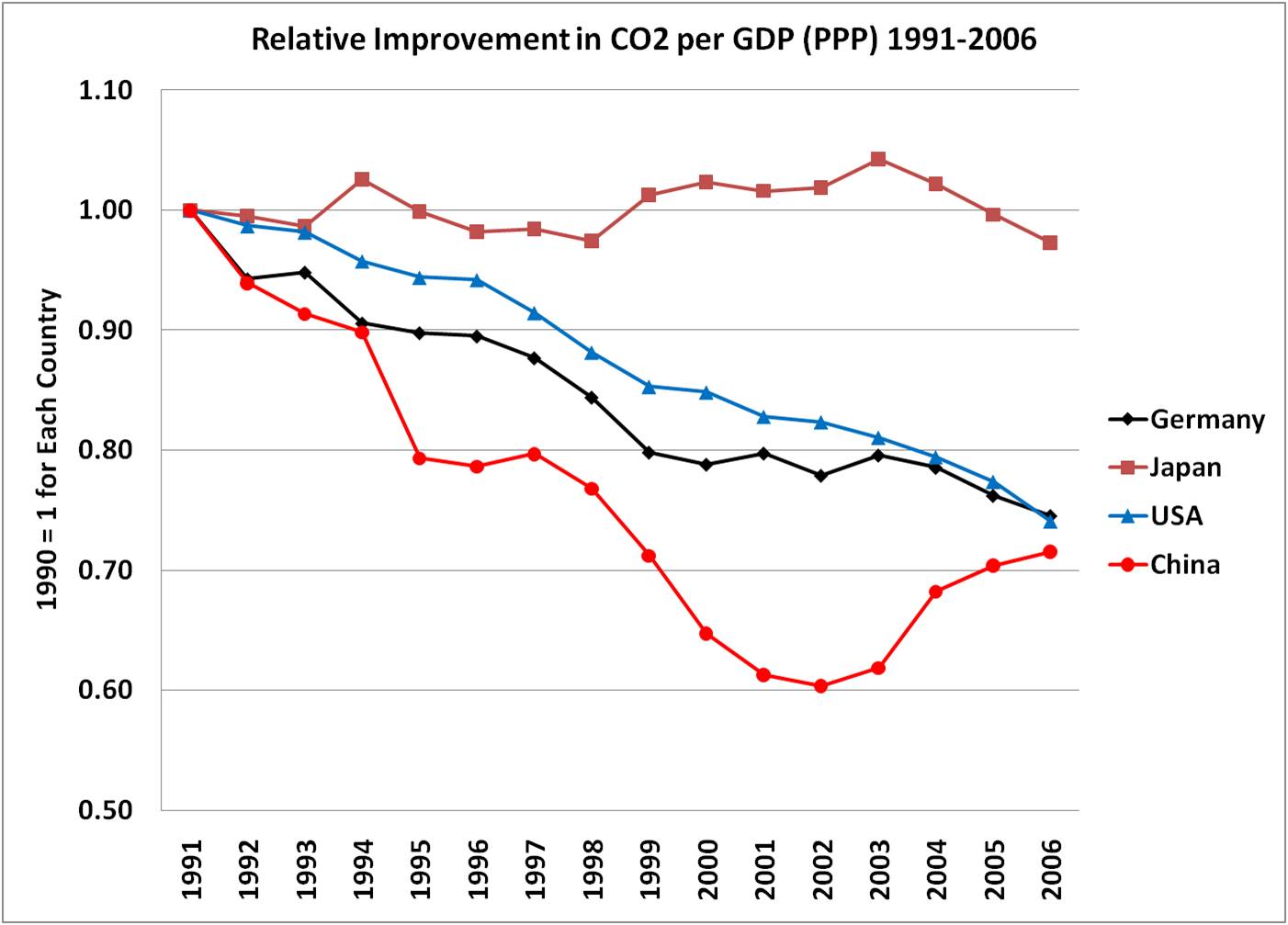Relative Improvements in CO2 Per GDP
January 13th, 2009Posted by: Roger Pielke, Jr.
The graph below shows relative improvements in carbon dioxide emissions for four countries (from the U.S. Energy Information Agency) per national GDP (as measured in PPP terms and reported by Maddison). The data starts in 1991, selected because it is the first year that the EIA reports total emissions for reunified Germany.
The graph shows some interesting, and to me at least, surprising things.
First, even though Japan is very efficient, it has made little to no progress is reducing carbon dioxide per unit of GDP.
Second, Germany and the United States show very similar total gains in reducions of carbon dioxide per unit GDP, though Germany is more efficient in absolute terms. If Europeans climate policies have a signal in emissions per GDP, you certainly can’t see it in this data.
Third, less surprising to regular readers of this blog, China has seen a rapid increase in carbon dioxide per GDP since 2000.
I can share this data for any country since 1980, so if you have requests or hypotheses, please share in the comments or send me an email.

January 13th, 2009 at 11:40 am
Does the rest of Europe track Germany?
January 13th, 2009 at 5:18 pm
The oil shock in 70s resulted in many policy changes in Japan which are only starting to be imposed in NA and the EU (i.e. mandating flourescent lighting, heavy investment in nuclear power, etc).
It is reasonable to assume that NA and the EU will hit a similar wall once the easy stuff is taken care off.
January 14th, 2009 at 5:43 am
I have a major problem with this dataset. I understand that it looks at efficiency, but economic efficiency is (imho) a terrible way of looking at the issue.
I wrote about this on my blog a year-and-a-half ago (see URL at the end of my post). My biggest beef with this way of looking at the world is that it doesn’t tackle one of the largest problems of CO2 emissions: pro-growth economic strategies.
So long as GDP grows faster than CO2 emission, then you get a negative slope. If your economy’s GDP has a significant portion of its economy in the financial sector (generally low CO2-producing, high GDP-producing) then it will “subsidize” the effect of “less efficient” sectors.
Furthermore, GDP is a horrible denominator for several reasons: it is not a standardizable measurement, it doesn’t include certain externalities (such as CO2 costs), can be inflated due to international investments, not linked closely to natural resource use, etc.
Of course, if people think I’m wrong, please let me know.
http://umlud.blogspot.com/2007/06/from-guardian-unlimited-china-overtakes_20.html
January 14th, 2009 at 7:29 am
If you’re offering: UK (to see “dash for gas”, if any), France (to see if there’s an effect as the nuclear build up saturates) and EU12, EU25 and India, just because…
January 14th, 2009 at 7:55 am
Hi, would just like to second OLiver’s request. thanks
January 14th, 2009 at 9:28 am
Thanks, I’ve received a bunch of requests and additional info via email as well. So in coming days I will post up some replies, starting with discussions of the EU12 and Japan.